|
Jupiter |
|
If travel agents could give tours of the solar system, Jupiter would rank as one of the most fascinating — if dangerous — destinations on the itinerary. Getting there would be quite a feat, as the planet orbits the Sun more than 600 million kilometers from Earth. The Voyager spacecraft left Earth to visit Jupiter in late 1977, arriving at the giant planet in March and July 1979. Of course, they weren't built to carry human life — instead they carried a complement of instruments designed to image the Jovian cloud tops and moons, measure the planet's magnetic fields, and study its radio emissions. |
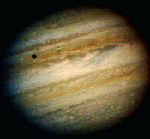 |
|
Traveling to Jupiter would take an incredibly long time for humans. In 1969, the astronauts traveled to the moon in just under three days. Jupiter is more than 1500 times farther away from Earth than the moon. Even taking into account the development of slightly faster spaceships to travel between the planets — say the NASA equivalent of the a space Concorde, it would take nearly 13 years to get there — a little longer than most of us might want to spend on a pleasure cruise. This is because our luxury liner spacecraft has to be bigger and better shielded than the Voyager spacecraft which raced out to Jupiter nearly 20 years ago. It also would have to accelerate to much higher velocities if the passengers wanted to make the trip in a shorter time. Sounds like we need a Federation Starship, doesn't it? Until the day we get our hands on such a ship, however, exploring Jupiter is best done with flyby missions, such as the Pioneers and Voyagers of the 70's and 80's. Of course we have the Galileo mission, which is in orbit around Jupiter right now, and there's always the Hubble Space Telescope to do some Jovian studies from right here in Earth orbit. Some of the most intricately detailed images of the planet — such as the one below — came from the Voyager spacecraft. This one spotlights the Great Red Spot — a giant storm three Earth-diameters across. Notice the swirling cloud belts and zones, encompassing smaller white-colored storms. |
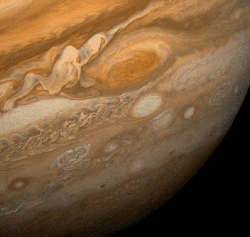
|
In 1994 we came to know Jupiter as the site of the Great Comet Crash, when 21 pieces of Comet Shoemaker-Levy 9 plowed into the upper cloud decks of the planet. The aftermath of those collisions included giant impact scars across the cloudtops and major flareups of Jovian aurorae around the planet's north and south poles. The Hubble Space Telescope images below reveal a variety of impact sites on Jupiter. The image on the left shows what the cloud tops looked like within a few hours of the G fragment impact. The image on the right shows Jupiter scarred with the remains of the E/F, H, N, Q and R fragment impacts. The center image is an ultraviolet study of the planet done 45 minutes after the comet's K fragment struck Jupiter. Particles kicked up by the impact found their way into the upper atmosphere of the planet, where they were caught in the magnetic field lines (drawn in to illustrate the process). Eventually those ionized particles reached the poles, where their interactions spurred bright aurorae (the bright spots at the top and bottom of the planet). 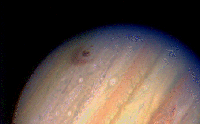 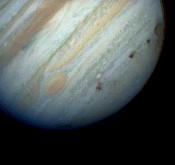 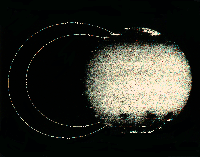 |
|
So, what do we know about Jupiter? |
|
We've always known that it's the largest planet in the Solar System. It is known as a gas giant for a very good reason — most of its mass is taken up with hydrogen gas. Those swirling cloud belts you see in the images are made up of mostly hydrogen and helium. What you see on the top "surface" of Jupiter's atmosphere are ammonia clouds, mixed with methane, ethane, acetylene and other hydrocarbons thrown in for good measure. Buried in the center of all this gas is a small rocky core, around 13,000 kilometers in radius. One unseen part of Jupiter — its magnetic field — is quite powerful. The zone of influence of the magnetic field — called the magnetosphere — encompasses an area of space that stretches out millions of kilometers from the planet. Buried within that region are Jupiter's moons, called Io, Europa, Ganymede and Callisto. Of these four worlds, Io has the most effect on Jupiter's magnetic field. Ions released from its volcanic surface are caught in the Jovian magnetic field lines. This cloud of charged particles form what planetary scientists call an "Io plasma torus" surrounding the planet. They are also at least partly responsible for the aurorae that shimmer above Jupiter's north and south poles. 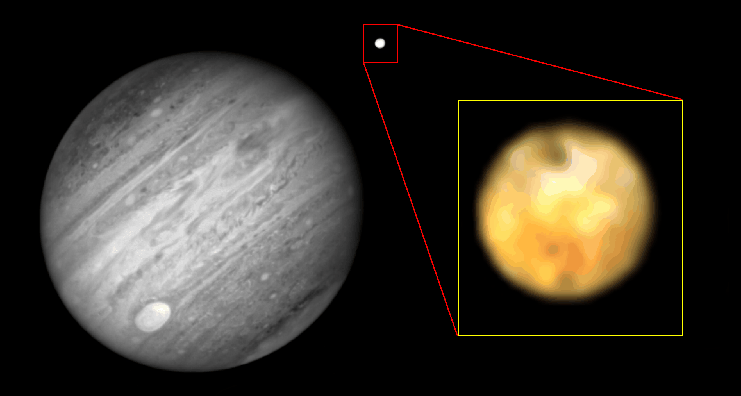 |
To go back to the gallery simply close this window.